Analysis of Samsung's Marketing and Branding Strategies: A Case Study
VerifiedAdded on 2022/12/15
|13
|1925
|125
Case Study
AI Summary
This case study examines the marketing and branding strategies of Samsung, a global leader in the electronics industry. It begins with an introduction to Samsung, including its history and current market position. The study then identifies Samsung's target market, considering geographic, demographic, behavioral, and psychographic factors. A SWOT analysis is conducted to assess Samsung's strengths, weaknesses, opportunities, and threats. The brand's positioning is analyzed using the Brand Characteristic Model, and the marketing mix (4Ps) is evaluated, covering product, promotion, pricing, and distribution strategies. The product life cycle of Samsung's mobile phones is discussed, and key competitors are identified. Trend research and value-added propositions are also explored, providing a comprehensive overview of Samsung's marketing efforts. The study concludes with a detailed analysis of the company's approach to the market.
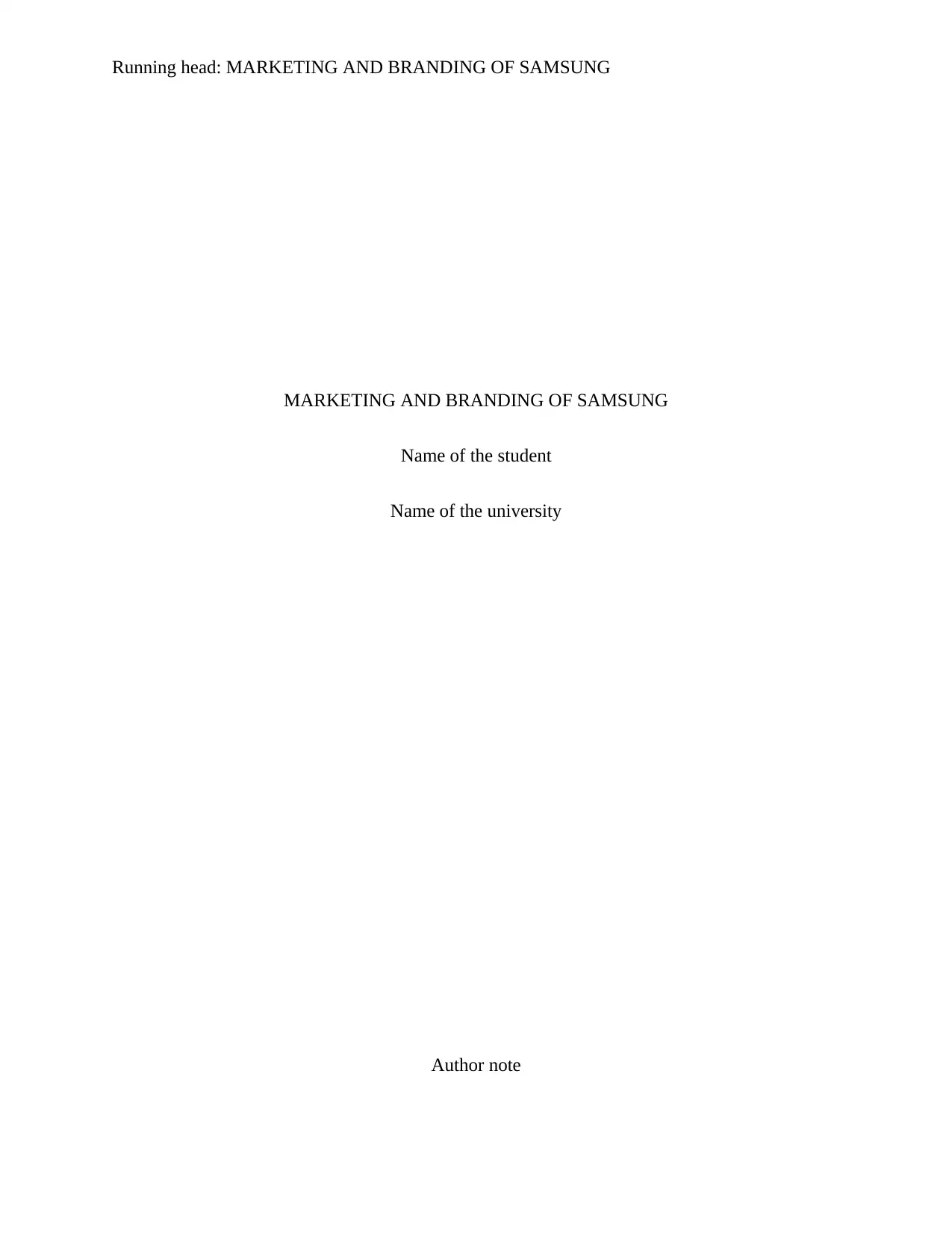
Running head: MARKETING AND BRANDING OF SAMSUNG
MARKETING AND BRANDING OF SAMSUNG
Name of the student
Name of the university
Author note
MARKETING AND BRANDING OF SAMSUNG
Name of the student
Name of the university
Author note
Paraphrase This Document
Need a fresh take? Get an instant paraphrase of this document with our AI Paraphraser
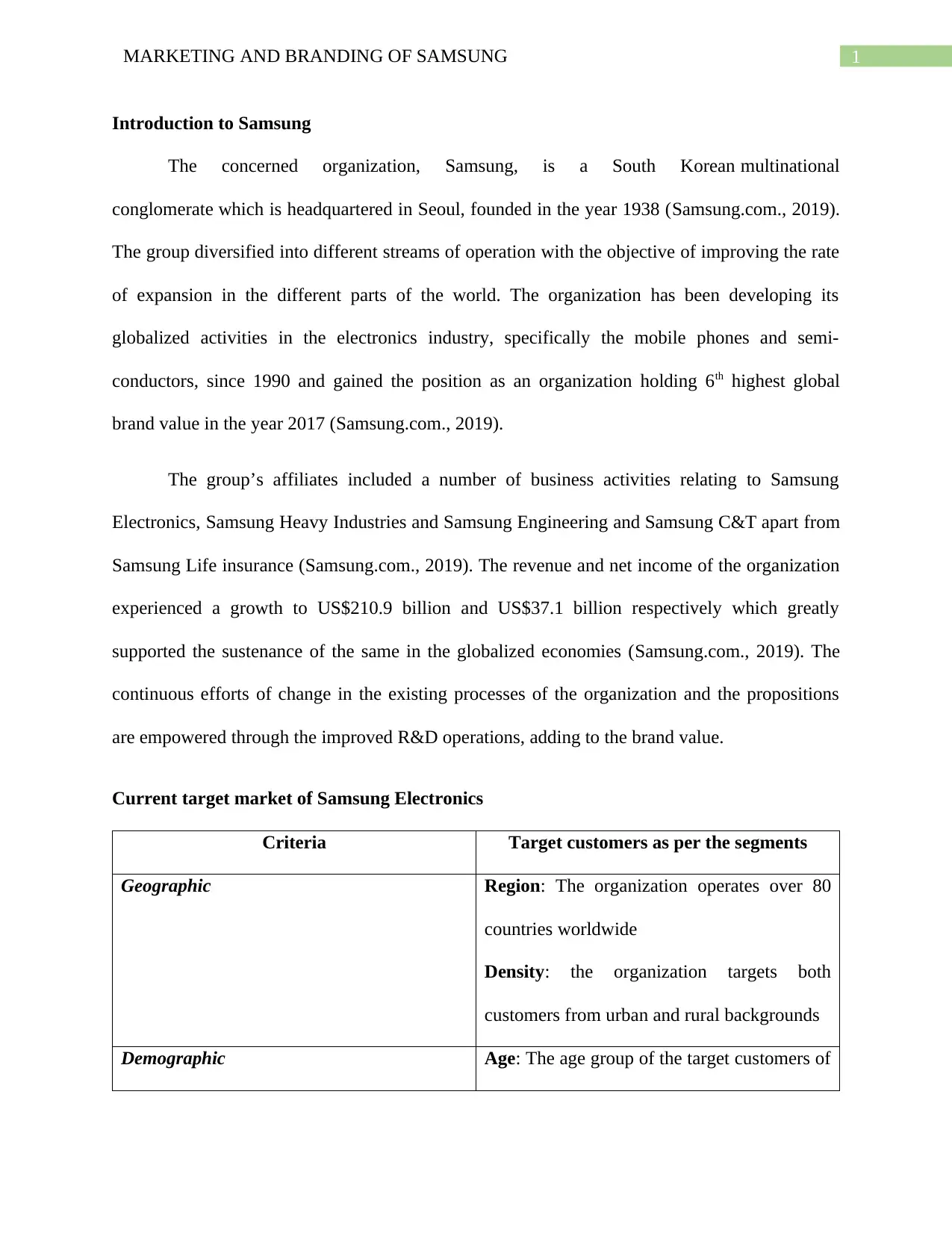
1MARKETING AND BRANDING OF SAMSUNG
Introduction to Samsung
The concerned organization, Samsung, is a South Korean multinational
conglomerate which is headquartered in Seoul, founded in the year 1938 (Samsung.com., 2019).
The group diversified into different streams of operation with the objective of improving the rate
of expansion in the different parts of the world. The organization has been developing its
globalized activities in the electronics industry, specifically the mobile phones and semi-
conductors, since 1990 and gained the position as an organization holding 6th highest global
brand value in the year 2017 (Samsung.com., 2019).
The group’s affiliates included a number of business activities relating to Samsung
Electronics, Samsung Heavy Industries and Samsung Engineering and Samsung C&T apart from
Samsung Life insurance (Samsung.com., 2019). The revenue and net income of the organization
experienced a growth to US$210.9 billion and US$37.1 billion respectively which greatly
supported the sustenance of the same in the globalized economies (Samsung.com., 2019). The
continuous efforts of change in the existing processes of the organization and the propositions
are empowered through the improved R&D operations, adding to the brand value.
Current target market of Samsung Electronics
Criteria Target customers as per the segments
Geographic Region: The organization operates over 80
countries worldwide
Density: the organization targets both
customers from urban and rural backgrounds
Demographic Age: The age group of the target customers of
Introduction to Samsung
The concerned organization, Samsung, is a South Korean multinational
conglomerate which is headquartered in Seoul, founded in the year 1938 (Samsung.com., 2019).
The group diversified into different streams of operation with the objective of improving the rate
of expansion in the different parts of the world. The organization has been developing its
globalized activities in the electronics industry, specifically the mobile phones and semi-
conductors, since 1990 and gained the position as an organization holding 6th highest global
brand value in the year 2017 (Samsung.com., 2019).
The group’s affiliates included a number of business activities relating to Samsung
Electronics, Samsung Heavy Industries and Samsung Engineering and Samsung C&T apart from
Samsung Life insurance (Samsung.com., 2019). The revenue and net income of the organization
experienced a growth to US$210.9 billion and US$37.1 billion respectively which greatly
supported the sustenance of the same in the globalized economies (Samsung.com., 2019). The
continuous efforts of change in the existing processes of the organization and the propositions
are empowered through the improved R&D operations, adding to the brand value.
Current target market of Samsung Electronics
Criteria Target customers as per the segments
Geographic Region: The organization operates over 80
countries worldwide
Density: the organization targets both
customers from urban and rural backgrounds
Demographic Age: The age group of the target customers of
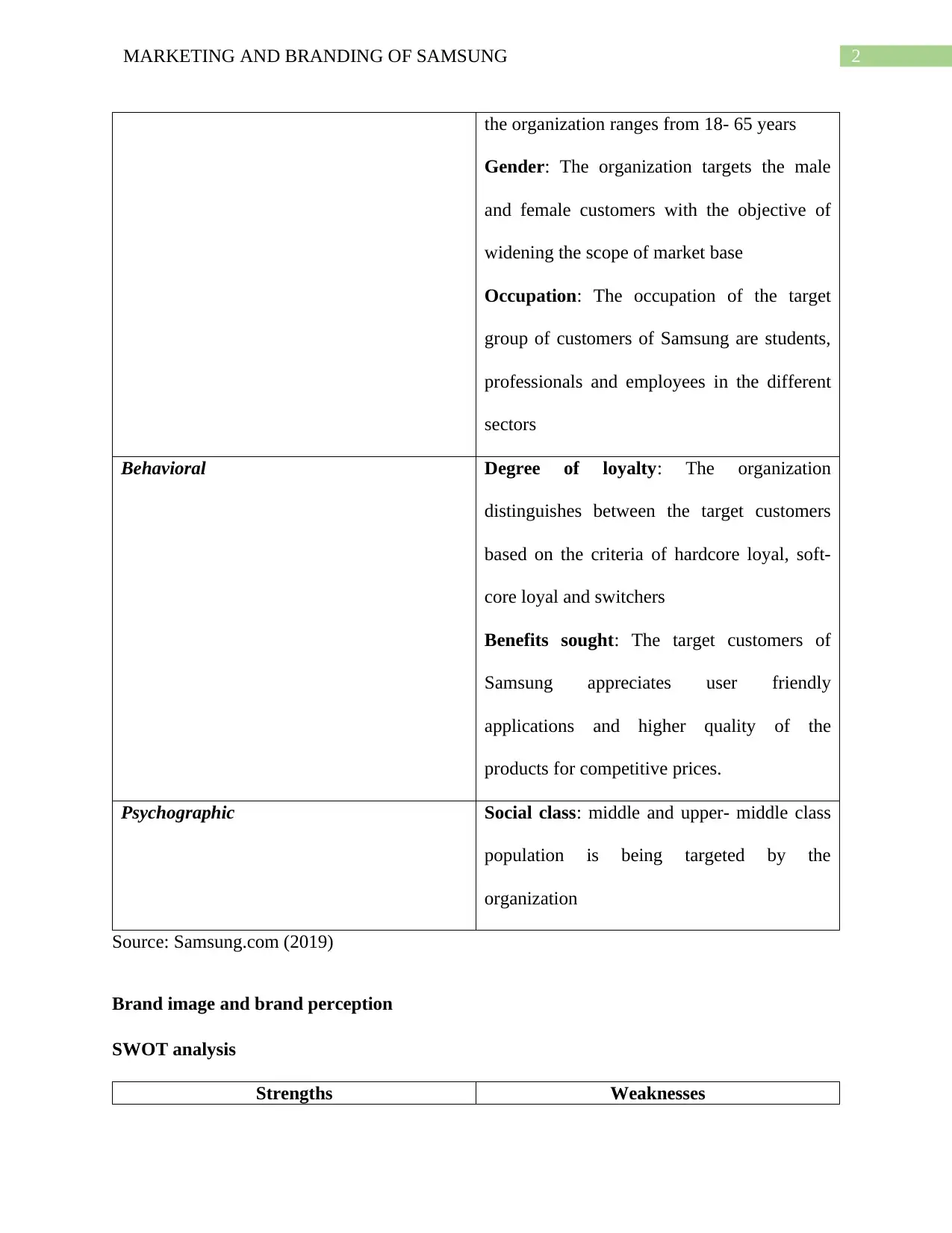
2MARKETING AND BRANDING OF SAMSUNG
the organization ranges from 18- 65 years
Gender: The organization targets the male
and female customers with the objective of
widening the scope of market base
Occupation: The occupation of the target
group of customers of Samsung are students,
professionals and employees in the different
sectors
Behavioral Degree of loyalty: The organization
distinguishes between the target customers
based on the criteria of hardcore loyal, soft-
core loyal and switchers
Benefits sought: The target customers of
Samsung appreciates user friendly
applications and higher quality of the
products for competitive prices.
Psychographic Social class: middle and upper- middle class
population is being targeted by the
organization
Source: Samsung.com (2019)
Brand image and brand perception
SWOT analysis
Strengths Weaknesses
the organization ranges from 18- 65 years
Gender: The organization targets the male
and female customers with the objective of
widening the scope of market base
Occupation: The occupation of the target
group of customers of Samsung are students,
professionals and employees in the different
sectors
Behavioral Degree of loyalty: The organization
distinguishes between the target customers
based on the criteria of hardcore loyal, soft-
core loyal and switchers
Benefits sought: The target customers of
Samsung appreciates user friendly
applications and higher quality of the
products for competitive prices.
Psychographic Social class: middle and upper- middle class
population is being targeted by the
organization
Source: Samsung.com (2019)
Brand image and brand perception
SWOT analysis
Strengths Weaknesses
⊘ This is a preview!⊘
Do you want full access?
Subscribe today to unlock all pages.

Trusted by 1+ million students worldwide
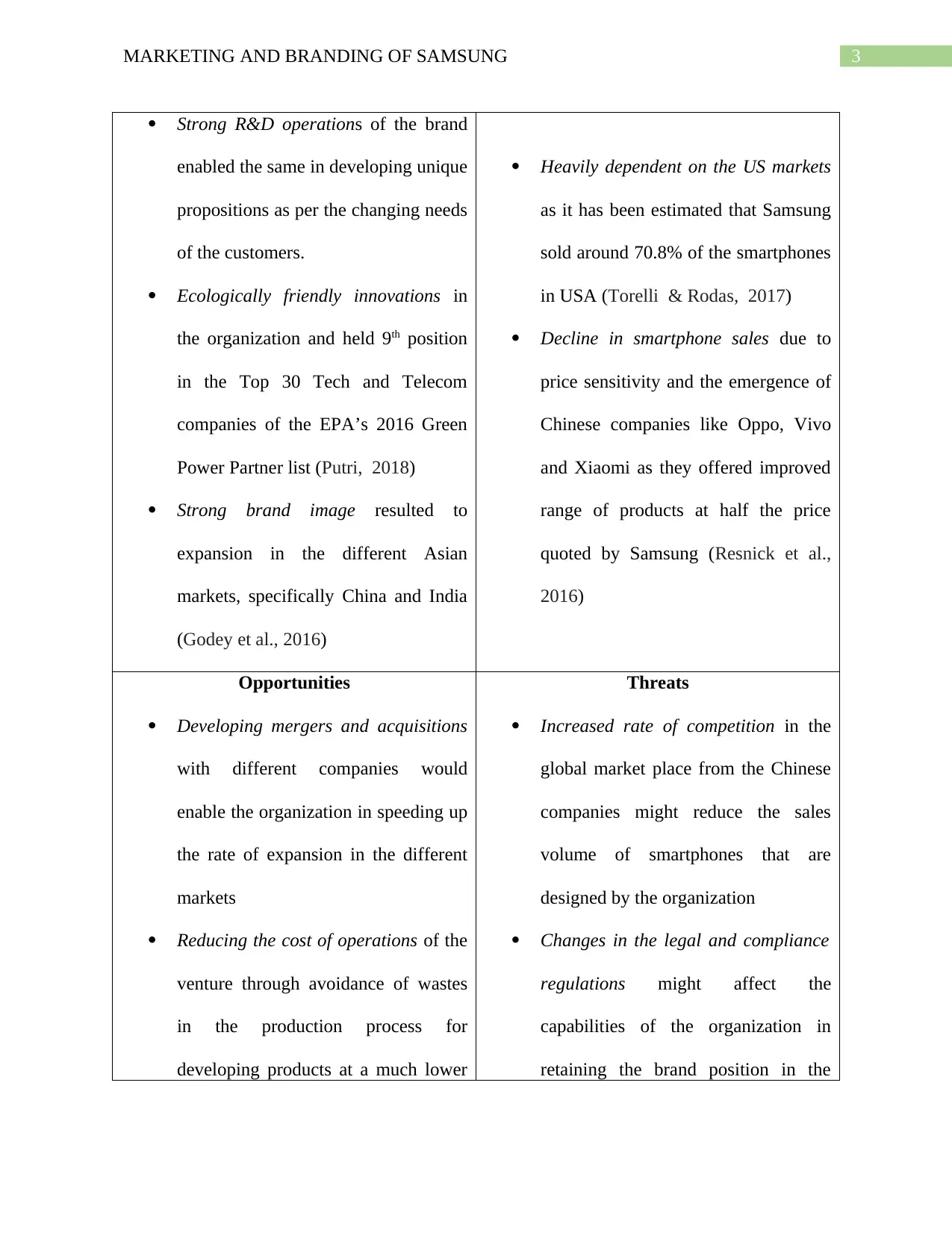
3MARKETING AND BRANDING OF SAMSUNG
Strong R&D operations of the brand
enabled the same in developing unique
propositions as per the changing needs
of the customers.
Ecologically friendly innovations in
the organization and held 9th position
in the Top 30 Tech and Telecom
companies of the EPA’s 2016 Green
Power Partner list (Putri, 2018)
Strong brand image resulted to
expansion in the different Asian
markets, specifically China and India
(Godey et al., 2016)
Heavily dependent on the US markets
as it has been estimated that Samsung
sold around 70.8% of the smartphones
in USA (Torelli & Rodas, 2017)
Decline in smartphone sales due to
price sensitivity and the emergence of
Chinese companies like Oppo, Vivo
and Xiaomi as they offered improved
range of products at half the price
quoted by Samsung (Resnick et al.,
2016)
Opportunities
Developing mergers and acquisitions
with different companies would
enable the organization in speeding up
the rate of expansion in the different
markets
Reducing the cost of operations of the
venture through avoidance of wastes
in the production process for
developing products at a much lower
Threats
Increased rate of competition in the
global market place from the Chinese
companies might reduce the sales
volume of smartphones that are
designed by the organization
Changes in the legal and compliance
regulations might affect the
capabilities of the organization in
retaining the brand position in the
Strong R&D operations of the brand
enabled the same in developing unique
propositions as per the changing needs
of the customers.
Ecologically friendly innovations in
the organization and held 9th position
in the Top 30 Tech and Telecom
companies of the EPA’s 2016 Green
Power Partner list (Putri, 2018)
Strong brand image resulted to
expansion in the different Asian
markets, specifically China and India
(Godey et al., 2016)
Heavily dependent on the US markets
as it has been estimated that Samsung
sold around 70.8% of the smartphones
in USA (Torelli & Rodas, 2017)
Decline in smartphone sales due to
price sensitivity and the emergence of
Chinese companies like Oppo, Vivo
and Xiaomi as they offered improved
range of products at half the price
quoted by Samsung (Resnick et al.,
2016)
Opportunities
Developing mergers and acquisitions
with different companies would
enable the organization in speeding up
the rate of expansion in the different
markets
Reducing the cost of operations of the
venture through avoidance of wastes
in the production process for
developing products at a much lower
Threats
Increased rate of competition in the
global market place from the Chinese
companies might reduce the sales
volume of smartphones that are
designed by the organization
Changes in the legal and compliance
regulations might affect the
capabilities of the organization in
retaining the brand position in the
Paraphrase This Document
Need a fresh take? Get an instant paraphrase of this document with our AI Paraphraser
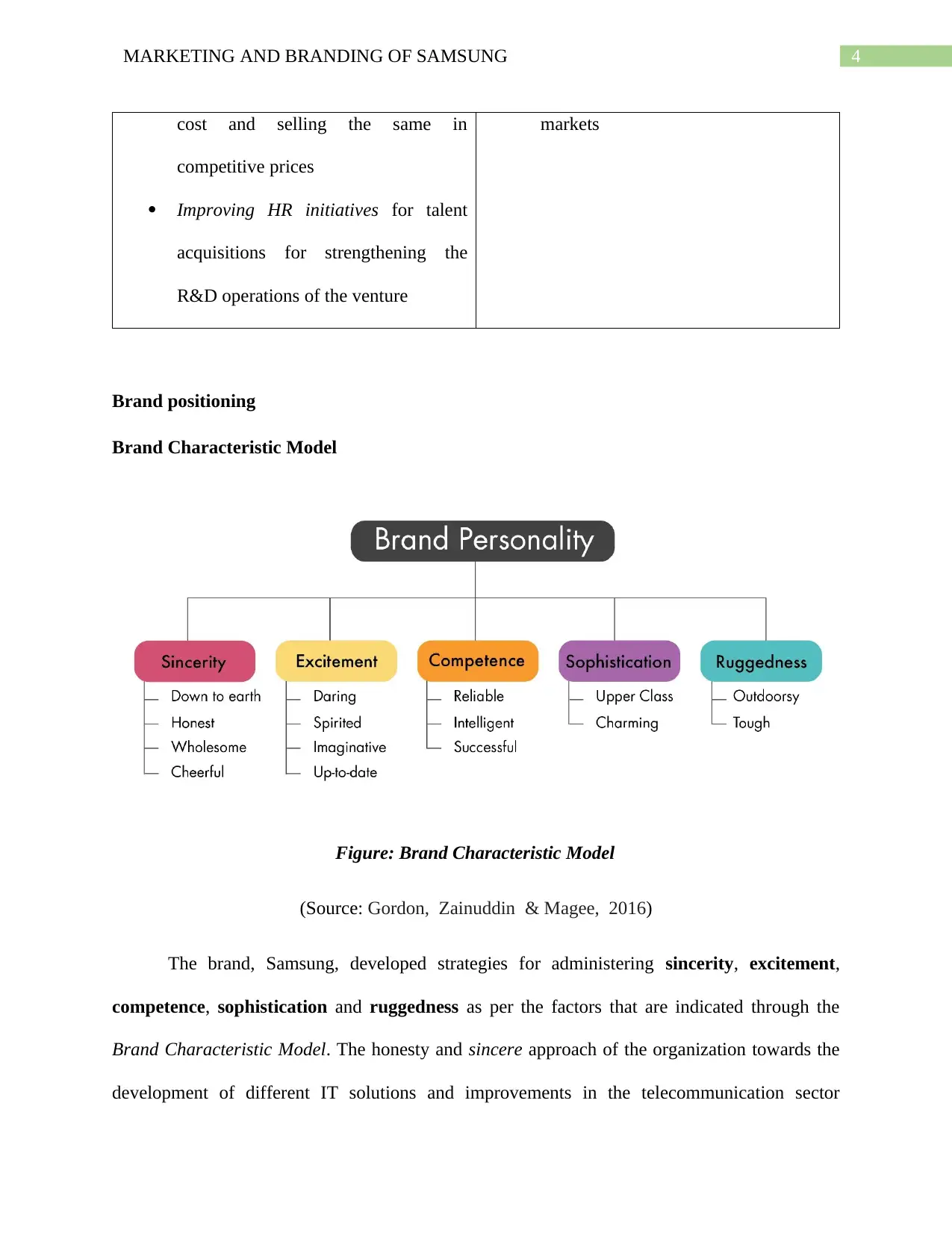
4MARKETING AND BRANDING OF SAMSUNG
cost and selling the same in
competitive prices
Improving HR initiatives for talent
acquisitions for strengthening the
R&D operations of the venture
markets
Brand positioning
Brand Characteristic Model
Figure: Brand Characteristic Model
(Source: Gordon, Zainuddin & Magee, 2016)
The brand, Samsung, developed strategies for administering sincerity, excitement,
competence, sophistication and ruggedness as per the factors that are indicated through the
Brand Characteristic Model. The honesty and sincere approach of the organization towards the
development of different IT solutions and improvements in the telecommunication sector
cost and selling the same in
competitive prices
Improving HR initiatives for talent
acquisitions for strengthening the
R&D operations of the venture
markets
Brand positioning
Brand Characteristic Model
Figure: Brand Characteristic Model
(Source: Gordon, Zainuddin & Magee, 2016)
The brand, Samsung, developed strategies for administering sincerity, excitement,
competence, sophistication and ruggedness as per the factors that are indicated through the
Brand Characteristic Model. The honesty and sincere approach of the organization towards the
development of different IT solutions and improvements in the telecommunication sector
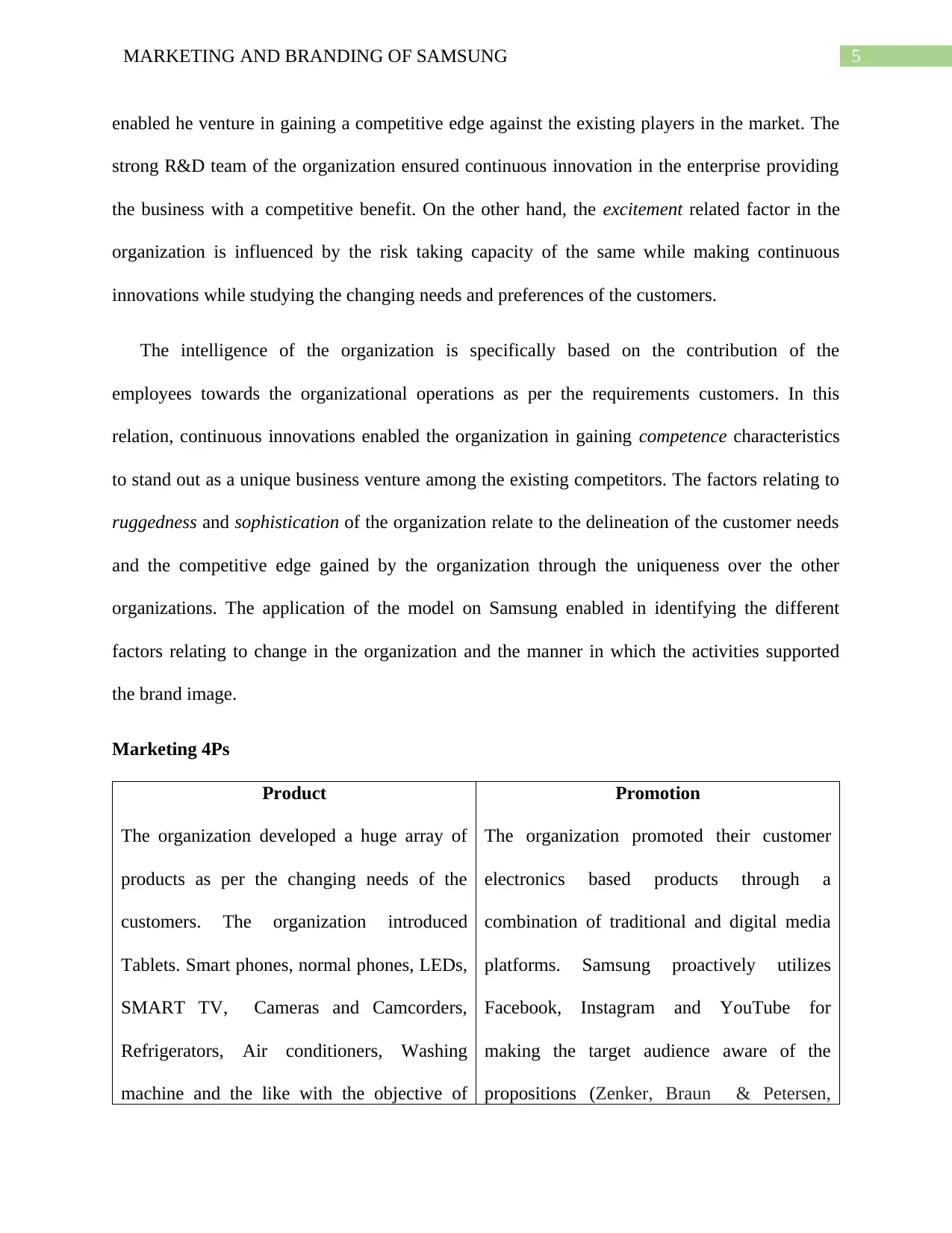
5MARKETING AND BRANDING OF SAMSUNG
enabled he venture in gaining a competitive edge against the existing players in the market. The
strong R&D team of the organization ensured continuous innovation in the enterprise providing
the business with a competitive benefit. On the other hand, the excitement related factor in the
organization is influenced by the risk taking capacity of the same while making continuous
innovations while studying the changing needs and preferences of the customers.
The intelligence of the organization is specifically based on the contribution of the
employees towards the organizational operations as per the requirements customers. In this
relation, continuous innovations enabled the organization in gaining competence characteristics
to stand out as a unique business venture among the existing competitors. The factors relating to
ruggedness and sophistication of the organization relate to the delineation of the customer needs
and the competitive edge gained by the organization through the uniqueness over the other
organizations. The application of the model on Samsung enabled in identifying the different
factors relating to change in the organization and the manner in which the activities supported
the brand image.
Marketing 4Ps
Product
The organization developed a huge array of
products as per the changing needs of the
customers. The organization introduced
Tablets. Smart phones, normal phones, LEDs,
SMART TV, Cameras and Camcorders,
Refrigerators, Air conditioners, Washing
machine and the like with the objective of
Promotion
The organization promoted their customer
electronics based products through a
combination of traditional and digital media
platforms. Samsung proactively utilizes
Facebook, Instagram and YouTube for
making the target audience aware of the
propositions (Zenker, Braun & Petersen,
enabled he venture in gaining a competitive edge against the existing players in the market. The
strong R&D team of the organization ensured continuous innovation in the enterprise providing
the business with a competitive benefit. On the other hand, the excitement related factor in the
organization is influenced by the risk taking capacity of the same while making continuous
innovations while studying the changing needs and preferences of the customers.
The intelligence of the organization is specifically based on the contribution of the
employees towards the organizational operations as per the requirements customers. In this
relation, continuous innovations enabled the organization in gaining competence characteristics
to stand out as a unique business venture among the existing competitors. The factors relating to
ruggedness and sophistication of the organization relate to the delineation of the customer needs
and the competitive edge gained by the organization through the uniqueness over the other
organizations. The application of the model on Samsung enabled in identifying the different
factors relating to change in the organization and the manner in which the activities supported
the brand image.
Marketing 4Ps
Product
The organization developed a huge array of
products as per the changing needs of the
customers. The organization introduced
Tablets. Smart phones, normal phones, LEDs,
SMART TV, Cameras and Camcorders,
Refrigerators, Air conditioners, Washing
machine and the like with the objective of
Promotion
The organization promoted their customer
electronics based products through a
combination of traditional and digital media
platforms. Samsung proactively utilizes
Facebook, Instagram and YouTube for
making the target audience aware of the
propositions (Zenker, Braun & Petersen,
⊘ This is a preview!⊘
Do you want full access?
Subscribe today to unlock all pages.

Trusted by 1+ million students worldwide
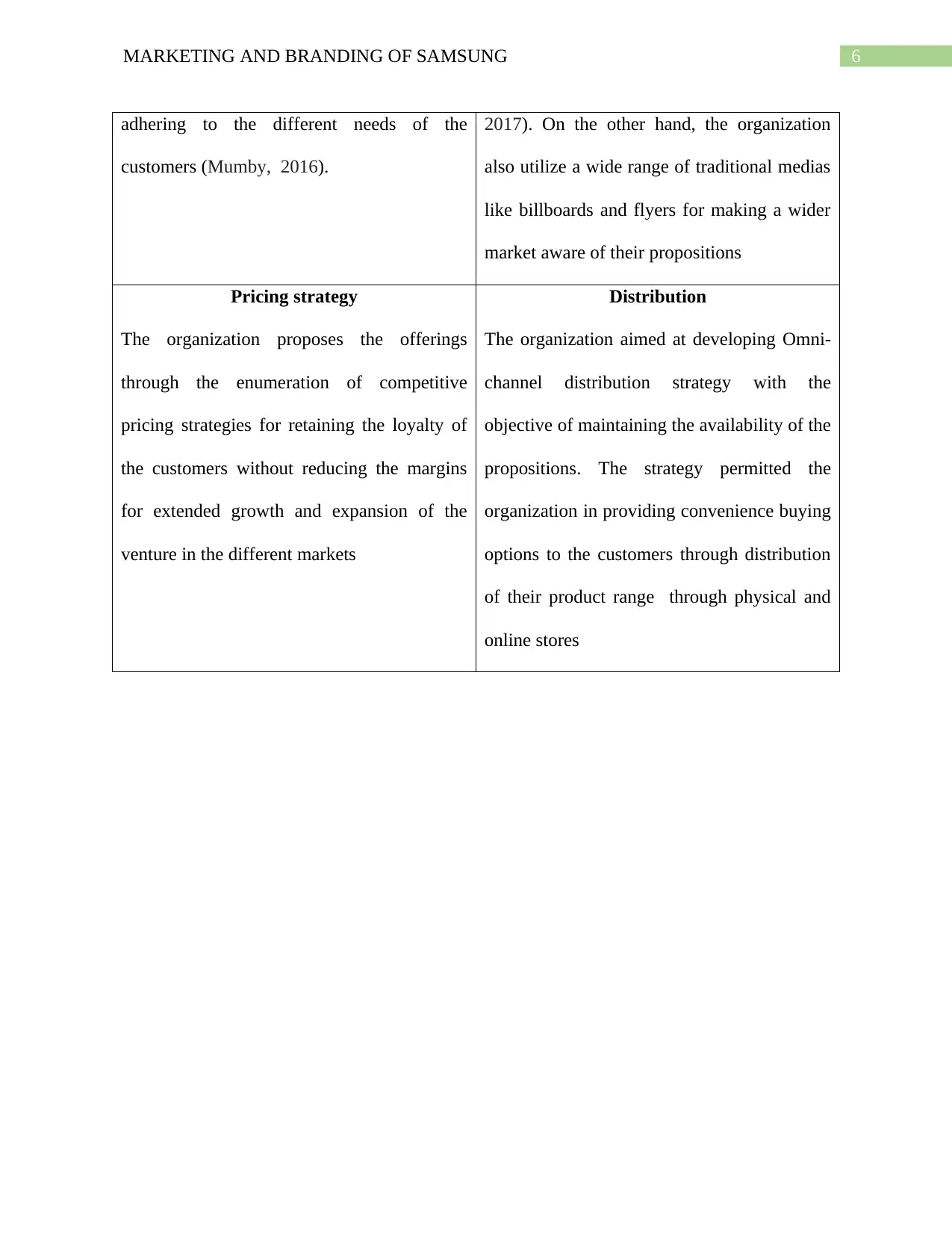
6MARKETING AND BRANDING OF SAMSUNG
adhering to the different needs of the
customers (Mumby, 2016).
2017). On the other hand, the organization
also utilize a wide range of traditional medias
like billboards and flyers for making a wider
market aware of their propositions
Pricing strategy
The organization proposes the offerings
through the enumeration of competitive
pricing strategies for retaining the loyalty of
the customers without reducing the margins
for extended growth and expansion of the
venture in the different markets
Distribution
The organization aimed at developing Omni-
channel distribution strategy with the
objective of maintaining the availability of the
propositions. The strategy permitted the
organization in providing convenience buying
options to the customers through distribution
of their product range through physical and
online stores
adhering to the different needs of the
customers (Mumby, 2016).
2017). On the other hand, the organization
also utilize a wide range of traditional medias
like billboards and flyers for making a wider
market aware of their propositions
Pricing strategy
The organization proposes the offerings
through the enumeration of competitive
pricing strategies for retaining the loyalty of
the customers without reducing the margins
for extended growth and expansion of the
venture in the different markets
Distribution
The organization aimed at developing Omni-
channel distribution strategy with the
objective of maintaining the availability of the
propositions. The strategy permitted the
organization in providing convenience buying
options to the customers through distribution
of their product range through physical and
online stores
Paraphrase This Document
Need a fresh take? Get an instant paraphrase of this document with our AI Paraphraser
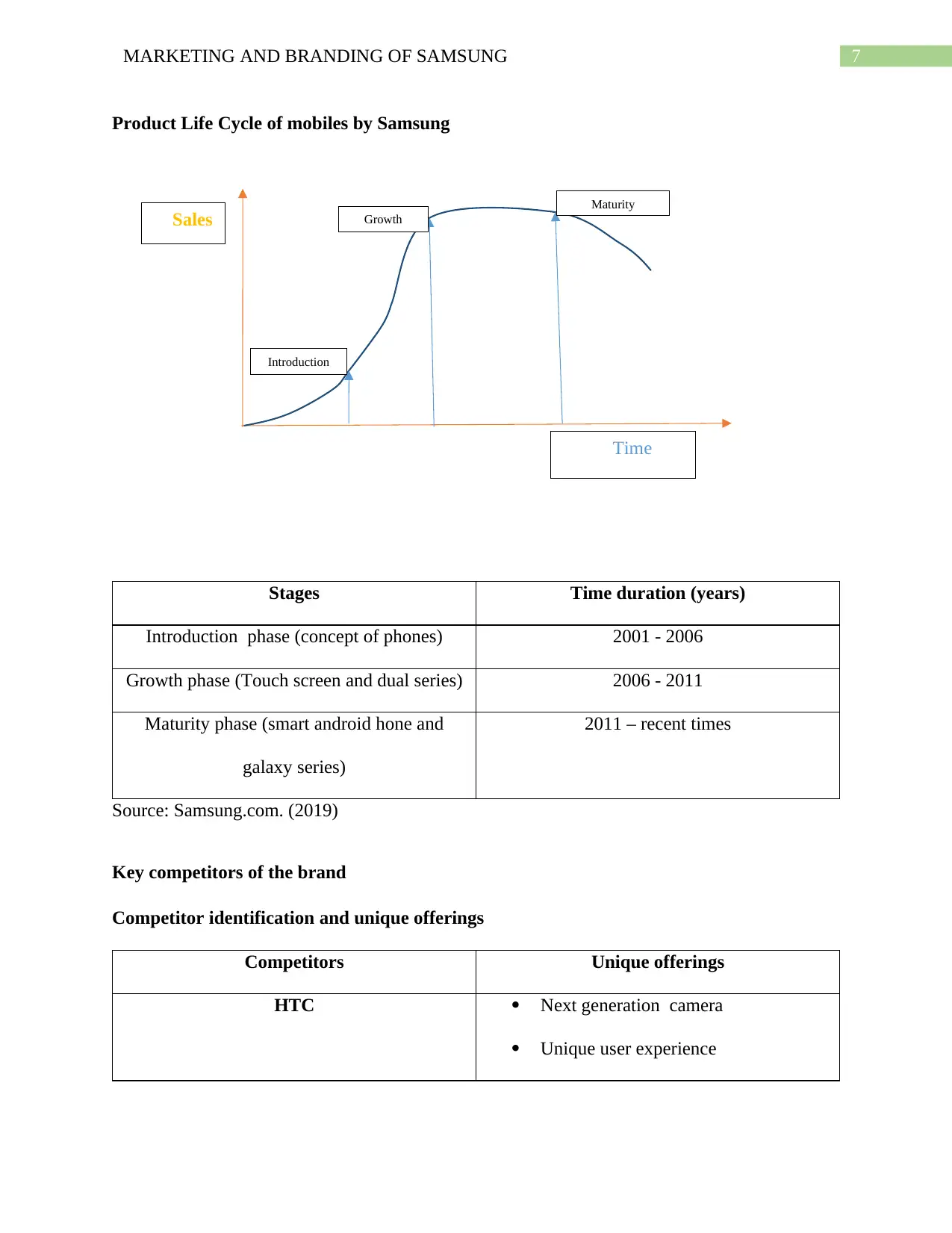
7MARKETING AND BRANDING OF SAMSUNG
Time
Introduction
Growth
Maturity
Sales
Product Life Cycle of mobiles by Samsung
Stages Time duration (years)
Introduction phase (concept of phones) 2001 - 2006
Growth phase (Touch screen and dual series) 2006 - 2011
Maturity phase (smart android hone and
galaxy series)
2011 – recent times
Source: Samsung.com. (2019)
Key competitors of the brand
Competitor identification and unique offerings
Competitors Unique offerings
HTC Next generation camera
Unique user experience
Time
Introduction
Growth
Maturity
Sales
Product Life Cycle of mobiles by Samsung
Stages Time duration (years)
Introduction phase (concept of phones) 2001 - 2006
Growth phase (Touch screen and dual series) 2006 - 2011
Maturity phase (smart android hone and
galaxy series)
2011 – recent times
Source: Samsung.com. (2019)
Key competitors of the brand
Competitor identification and unique offerings
Competitors Unique offerings
HTC Next generation camera
Unique user experience
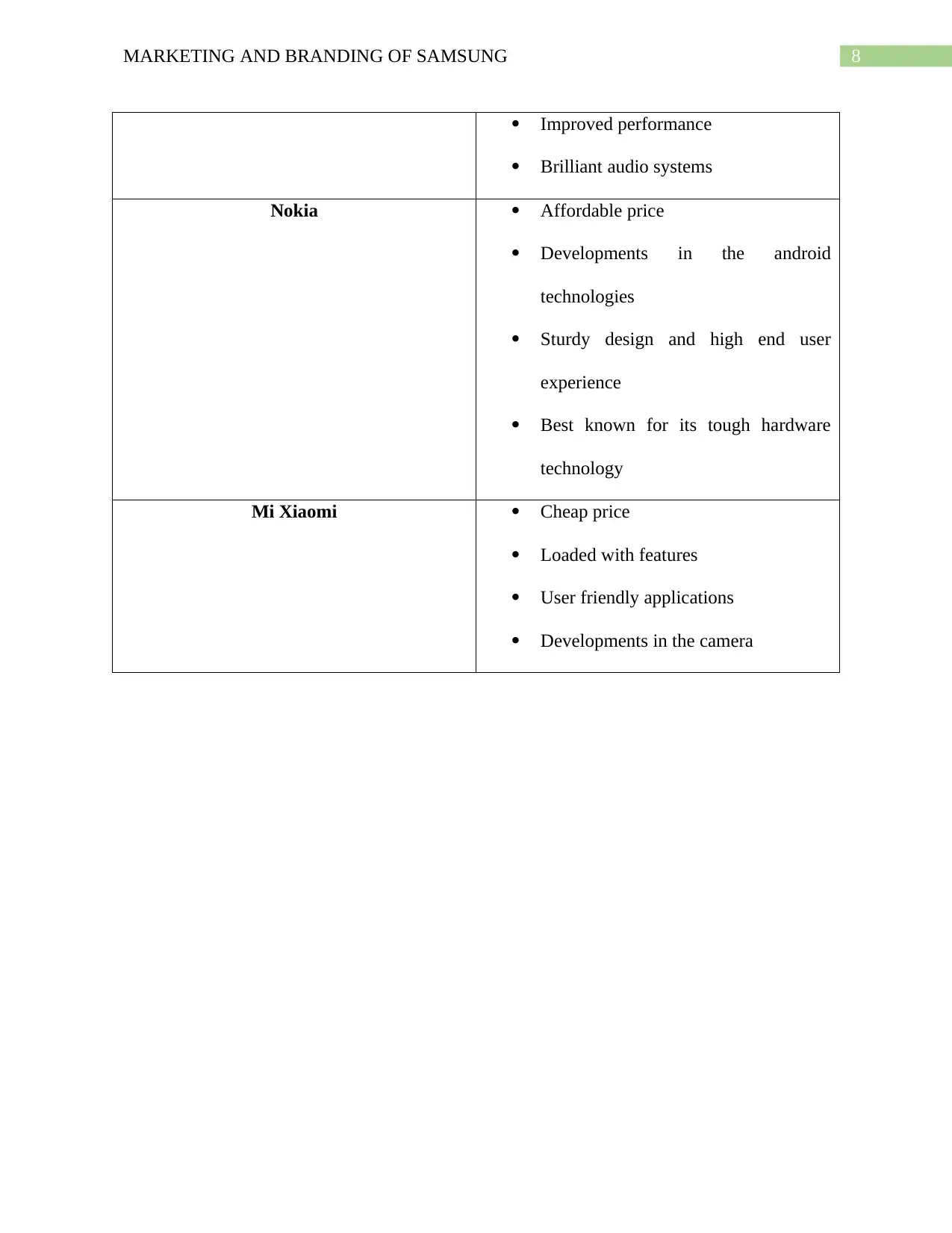
8MARKETING AND BRANDING OF SAMSUNG
Improved performance
Brilliant audio systems
Nokia Affordable price
Developments in the android
technologies
Sturdy design and high end user
experience
Best known for its tough hardware
technology
Mi Xiaomi Cheap price
Loaded with features
User friendly applications
Developments in the camera
Improved performance
Brilliant audio systems
Nokia Affordable price
Developments in the android
technologies
Sturdy design and high end user
experience
Best known for its tough hardware
technology
Mi Xiaomi Cheap price
Loaded with features
User friendly applications
Developments in the camera
⊘ This is a preview!⊘
Do you want full access?
Subscribe today to unlock all pages.

Trusted by 1+ million students worldwide
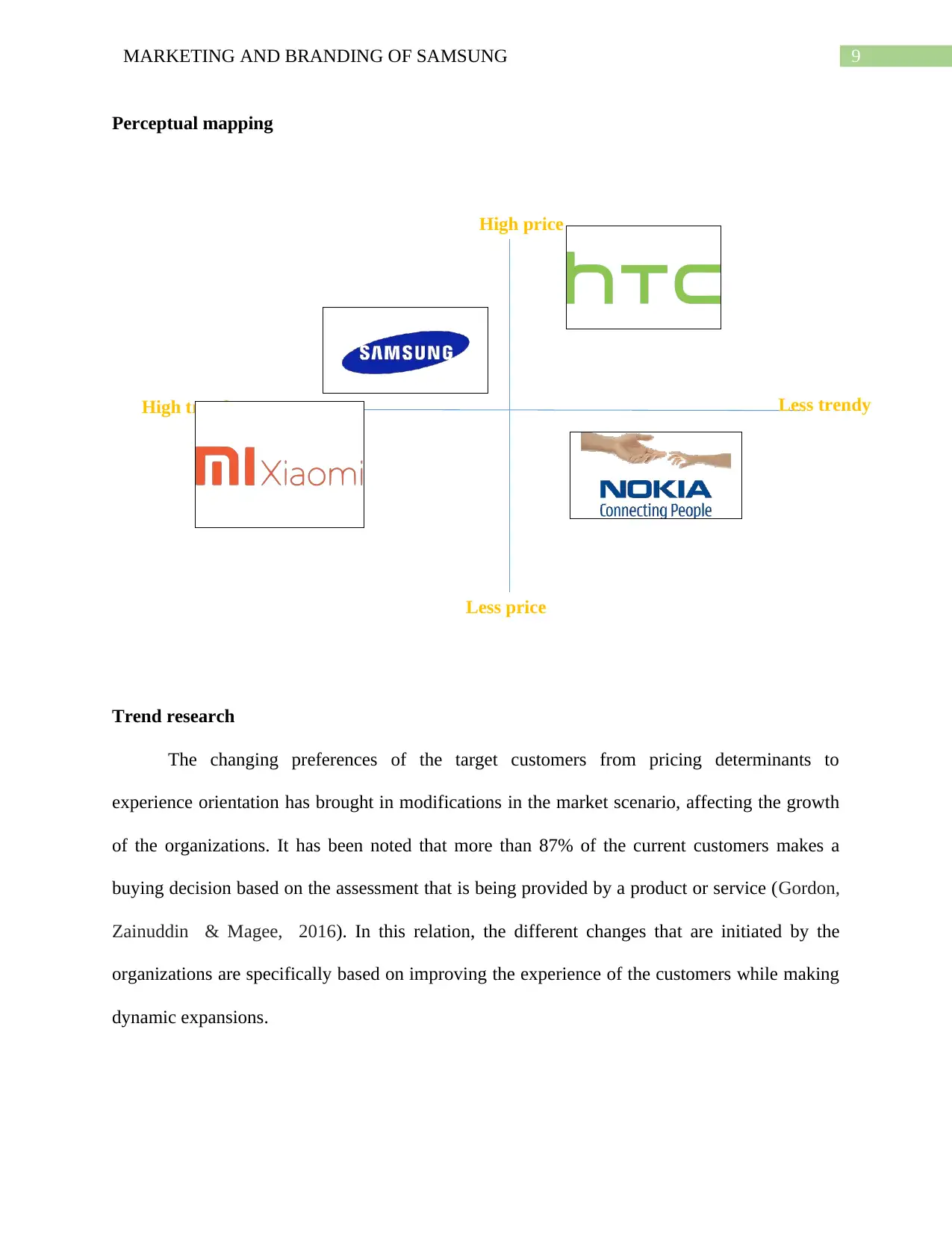
9MARKETING AND BRANDING OF SAMSUNG
High price
High trendy
Less price
Less trendy
Perceptual mapping
Trend research
The changing preferences of the target customers from pricing determinants to
experience orientation has brought in modifications in the market scenario, affecting the growth
of the organizations. It has been noted that more than 87% of the current customers makes a
buying decision based on the assessment that is being provided by a product or service (Gordon,
Zainuddin & Magee, 2016). In this relation, the different changes that are initiated by the
organizations are specifically based on improving the experience of the customers while making
dynamic expansions.
High price
High trendy
Less price
Less trendy
Perceptual mapping
Trend research
The changing preferences of the target customers from pricing determinants to
experience orientation has brought in modifications in the market scenario, affecting the growth
of the organizations. It has been noted that more than 87% of the current customers makes a
buying decision based on the assessment that is being provided by a product or service (Gordon,
Zainuddin & Magee, 2016). In this relation, the different changes that are initiated by the
organizations are specifically based on improving the experience of the customers while making
dynamic expansions.
Paraphrase This Document
Need a fresh take? Get an instant paraphrase of this document with our AI Paraphraser
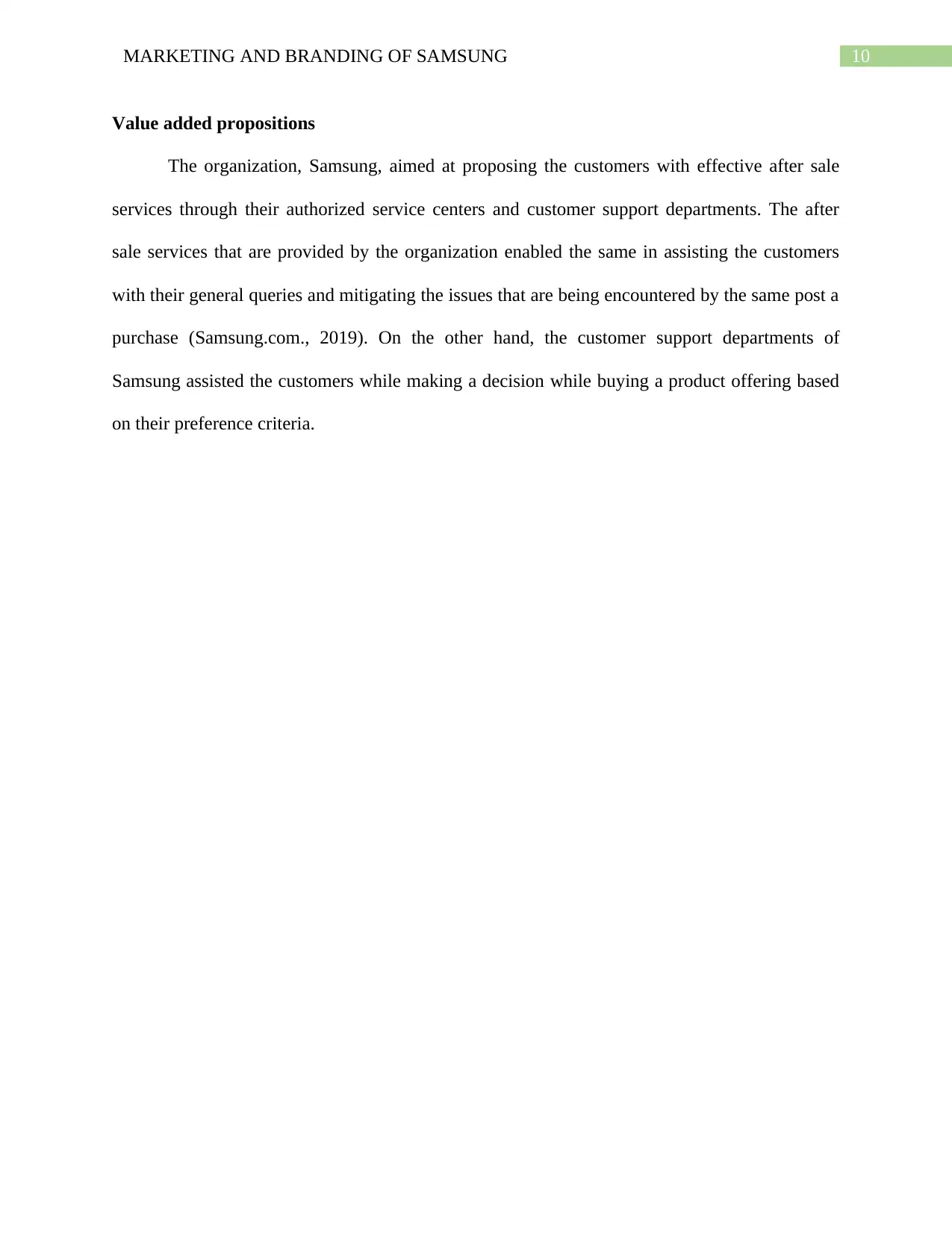
10MARKETING AND BRANDING OF SAMSUNG
Value added propositions
The organization, Samsung, aimed at proposing the customers with effective after sale
services through their authorized service centers and customer support departments. The after
sale services that are provided by the organization enabled the same in assisting the customers
with their general queries and mitigating the issues that are being encountered by the same post a
purchase (Samsung.com., 2019). On the other hand, the customer support departments of
Samsung assisted the customers while making a decision while buying a product offering based
on their preference criteria.
Value added propositions
The organization, Samsung, aimed at proposing the customers with effective after sale
services through their authorized service centers and customer support departments. The after
sale services that are provided by the organization enabled the same in assisting the customers
with their general queries and mitigating the issues that are being encountered by the same post a
purchase (Samsung.com., 2019). On the other hand, the customer support departments of
Samsung assisted the customers while making a decision while buying a product offering based
on their preference criteria.
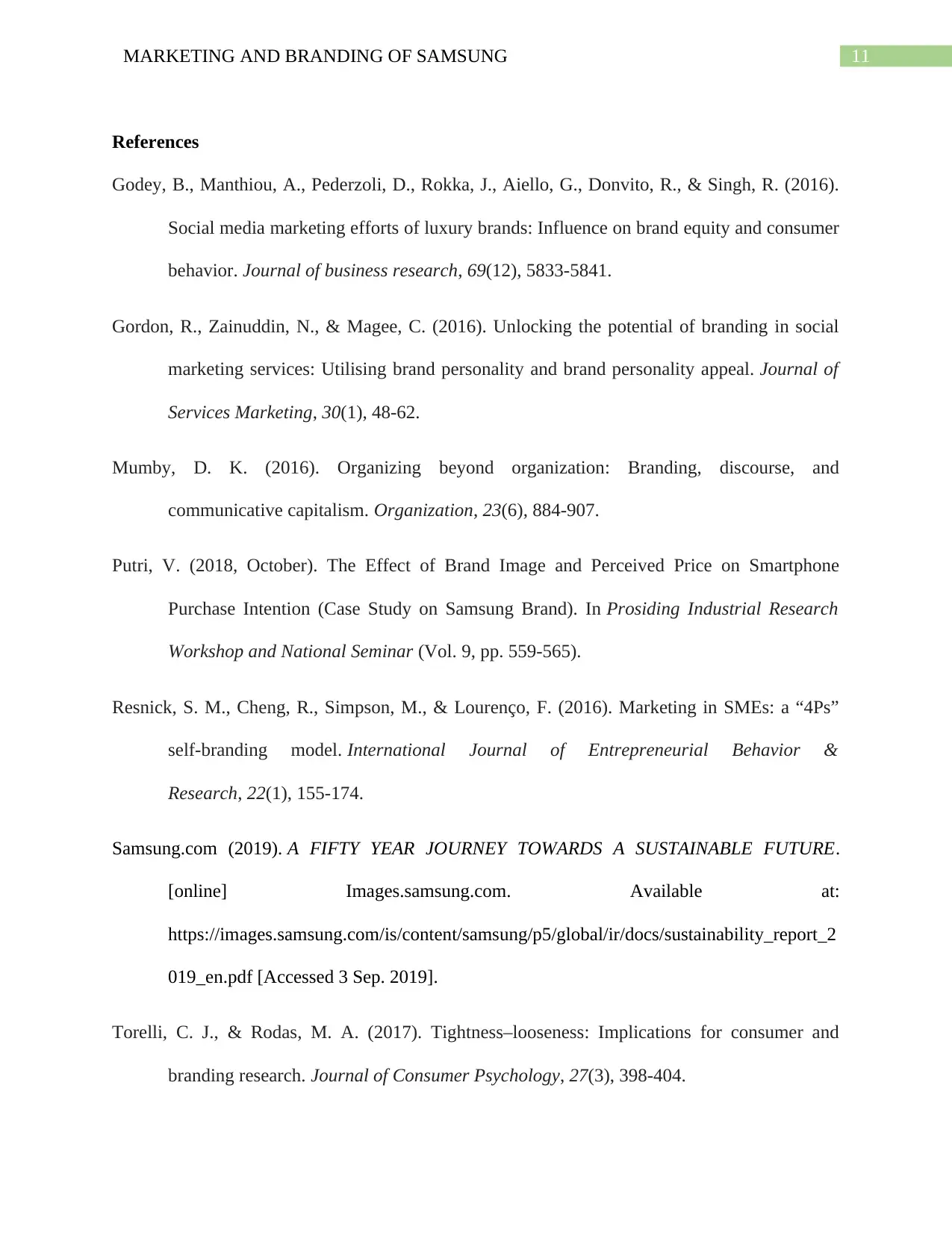
11MARKETING AND BRANDING OF SAMSUNG
References
Godey, B., Manthiou, A., Pederzoli, D., Rokka, J., Aiello, G., Donvito, R., & Singh, R. (2016).
Social media marketing efforts of luxury brands: Influence on brand equity and consumer
behavior. Journal of business research, 69(12), 5833-5841.
Gordon, R., Zainuddin, N., & Magee, C. (2016). Unlocking the potential of branding in social
marketing services: Utilising brand personality and brand personality appeal. Journal of
Services Marketing, 30(1), 48-62.
Mumby, D. K. (2016). Organizing beyond organization: Branding, discourse, and
communicative capitalism. Organization, 23(6), 884-907.
Putri, V. (2018, October). The Effect of Brand Image and Perceived Price on Smartphone
Purchase Intention (Case Study on Samsung Brand). In Prosiding Industrial Research
Workshop and National Seminar (Vol. 9, pp. 559-565).
Resnick, S. M., Cheng, R., Simpson, M., & Lourenço, F. (2016). Marketing in SMEs: a “4Ps”
self-branding model. International Journal of Entrepreneurial Behavior &
Research, 22(1), 155-174.
Samsung.com (2019). A FIFTY YEAR JOURNEY TOWARDS A SUSTAINABLE FUTURE.
[online] Images.samsung.com. Available at:
https://images.samsung.com/is/content/samsung/p5/global/ir/docs/sustainability_report_2
019_en.pdf [Accessed 3 Sep. 2019].
Torelli, C. J., & Rodas, M. A. (2017). Tightness–looseness: Implications for consumer and
branding research. Journal of Consumer Psychology, 27(3), 398-404.
References
Godey, B., Manthiou, A., Pederzoli, D., Rokka, J., Aiello, G., Donvito, R., & Singh, R. (2016).
Social media marketing efforts of luxury brands: Influence on brand equity and consumer
behavior. Journal of business research, 69(12), 5833-5841.
Gordon, R., Zainuddin, N., & Magee, C. (2016). Unlocking the potential of branding in social
marketing services: Utilising brand personality and brand personality appeal. Journal of
Services Marketing, 30(1), 48-62.
Mumby, D. K. (2016). Organizing beyond organization: Branding, discourse, and
communicative capitalism. Organization, 23(6), 884-907.
Putri, V. (2018, October). The Effect of Brand Image and Perceived Price on Smartphone
Purchase Intention (Case Study on Samsung Brand). In Prosiding Industrial Research
Workshop and National Seminar (Vol. 9, pp. 559-565).
Resnick, S. M., Cheng, R., Simpson, M., & Lourenço, F. (2016). Marketing in SMEs: a “4Ps”
self-branding model. International Journal of Entrepreneurial Behavior &
Research, 22(1), 155-174.
Samsung.com (2019). A FIFTY YEAR JOURNEY TOWARDS A SUSTAINABLE FUTURE.
[online] Images.samsung.com. Available at:
https://images.samsung.com/is/content/samsung/p5/global/ir/docs/sustainability_report_2
019_en.pdf [Accessed 3 Sep. 2019].
Torelli, C. J., & Rodas, M. A. (2017). Tightness–looseness: Implications for consumer and
branding research. Journal of Consumer Psychology, 27(3), 398-404.
⊘ This is a preview!⊘
Do you want full access?
Subscribe today to unlock all pages.

Trusted by 1+ million students worldwide
1 out of 13
Related Documents
Your All-in-One AI-Powered Toolkit for Academic Success.
+13062052269
info@desklib.com
Available 24*7 on WhatsApp / Email
![[object Object]](/_next/static/media/star-bottom.7253800d.svg)
Unlock your academic potential
Copyright © 2020–2025 A2Z Services. All Rights Reserved. Developed and managed by ZUCOL.




